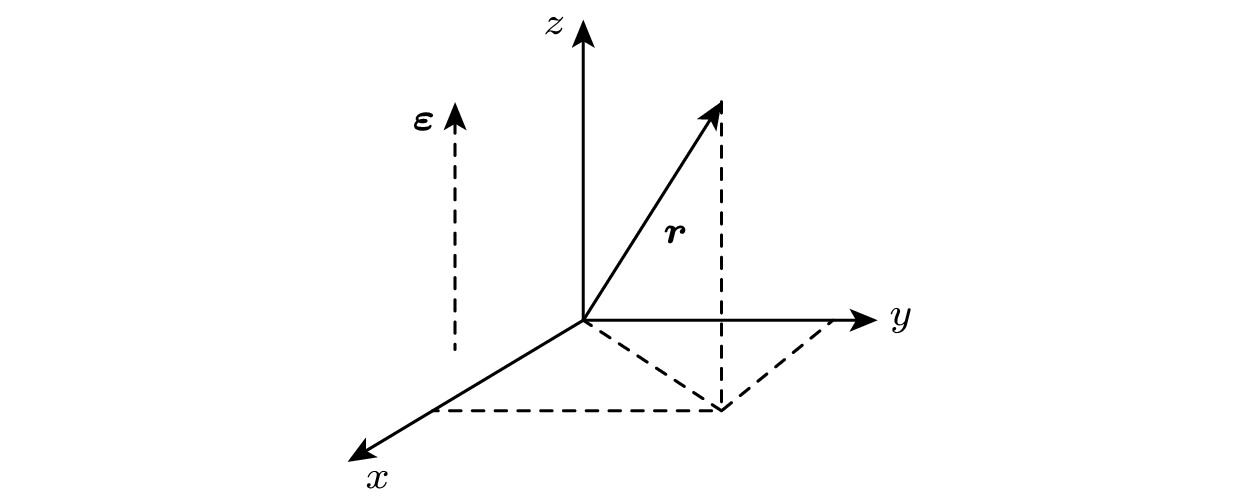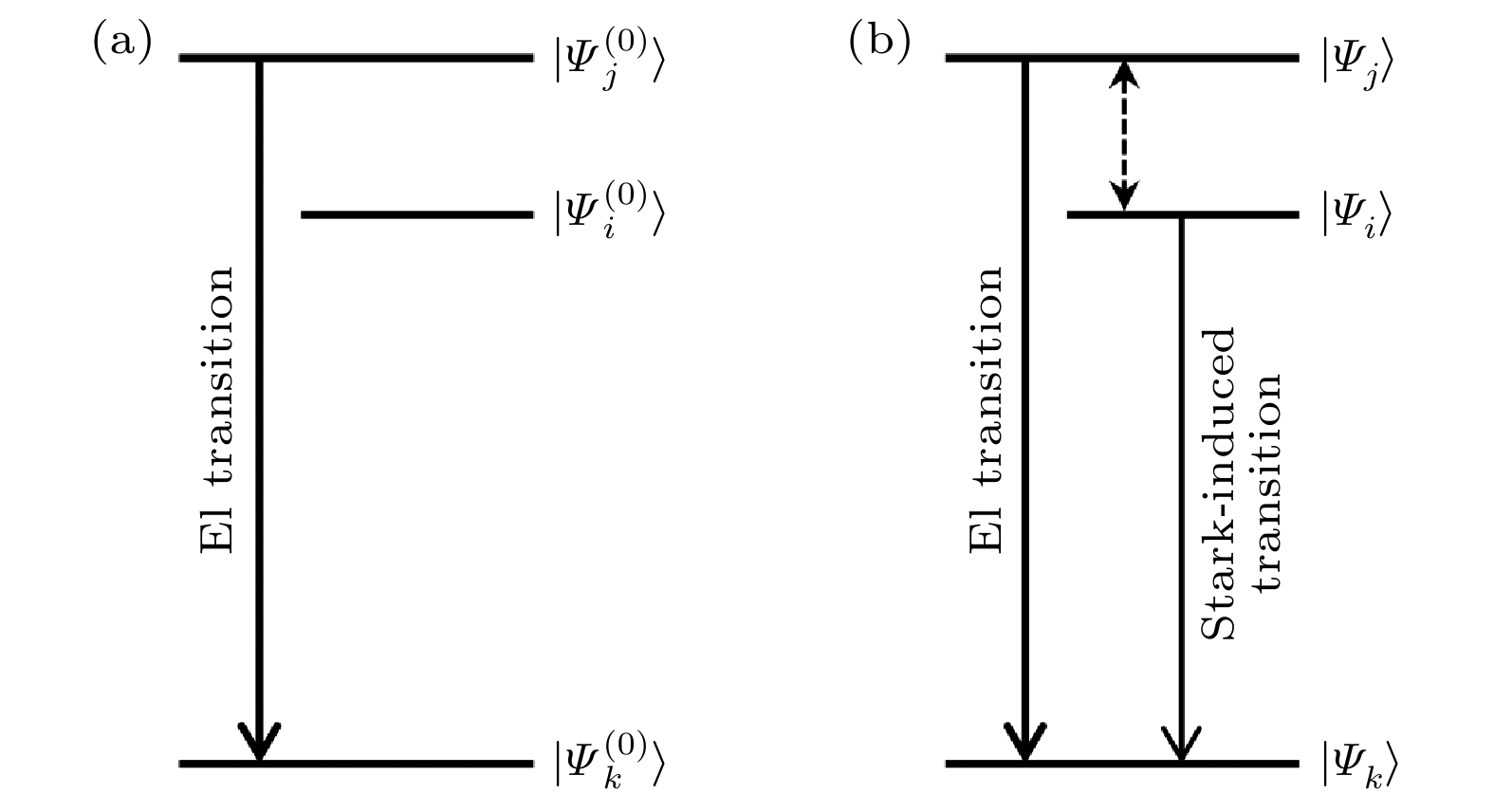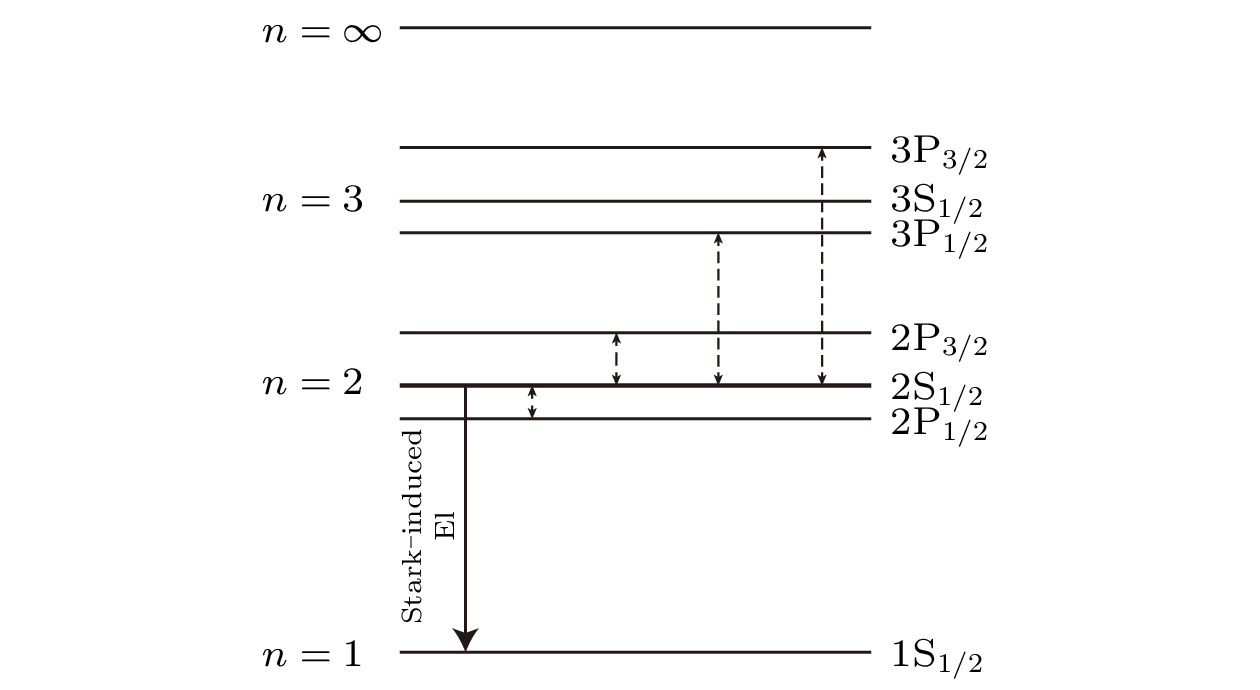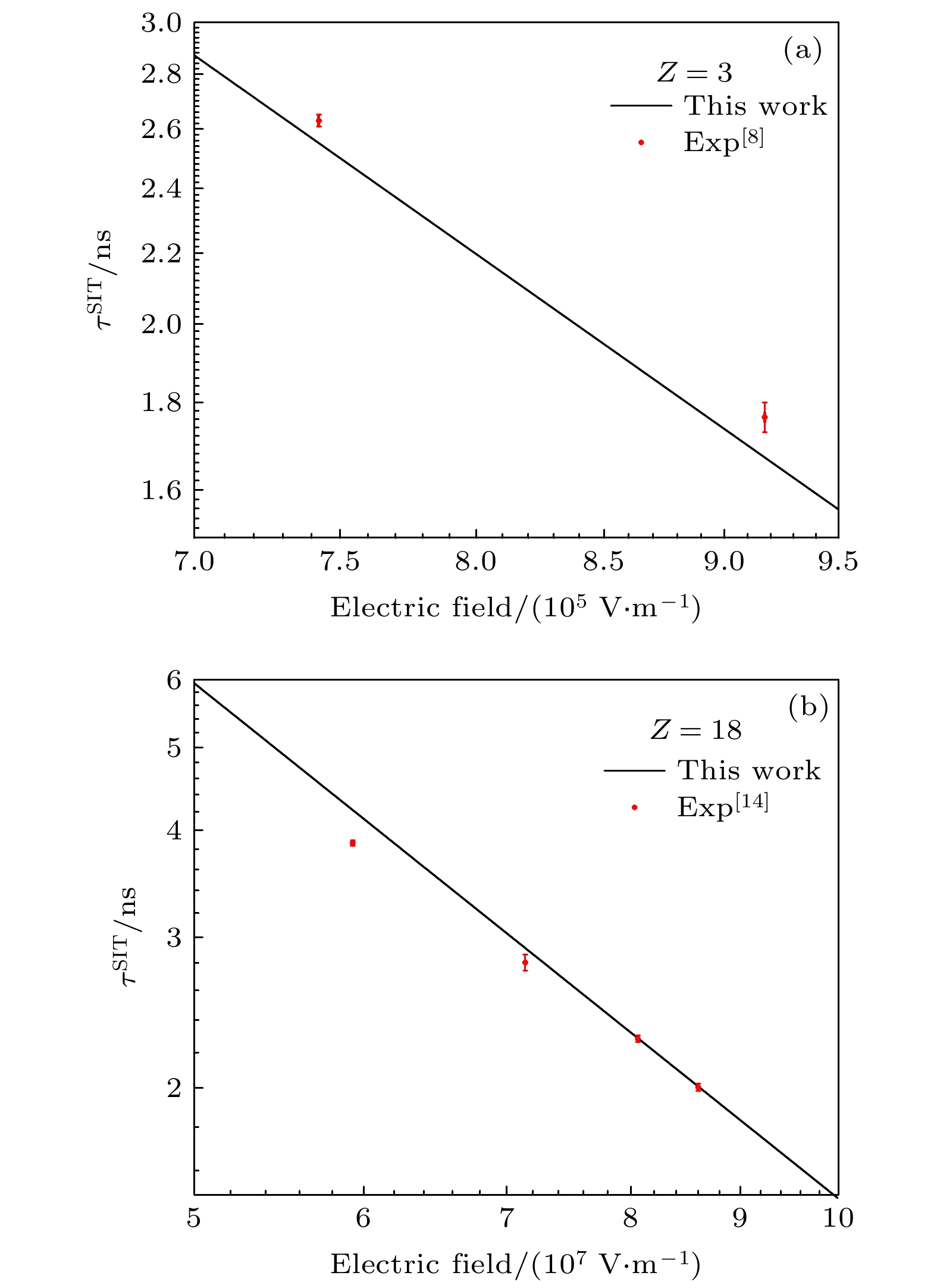-
Based on the nondegenerate perturbation theory, the Stark-induced transitions are studied for hydrogen-like isoelectronic sequences (Z = 1–92). The Stark-induced mixing coefficients and transition probabilities between the 2s1/2-1s1/2 levels of hydrogen-like ions are reported. The trend of Stark-induced transition probabilities varying with atomic number Z between 2s1/2-1s1/2 levels of hydrogen-like ions and the relativistic effect on the Stark-induced mixing coefficients and transition probabilities are discussed. The scaling relations of the nonrelativistic and relativistic Stark-induced transition probabilities with atomic number Z are obtained. The results show that the Stark-induced transition probabilities of hydrogen-like ions decrease monotonically along the isoelectronic sequence with the increase of atomic number Z. In addition, the relativistic effect reduces the Stark-induced transition probabilities of hydrogen-like ions, for example, by about 55% at Z = 92.
-
Keywords:
- Stark-induced transition /
- Stark effect /
- Hydrogen-like ions /
- scaling law
[1] Bucksbaum P, Commins E D, Hunter L 1981 Phys. Rev. Lett. 46 640
 Google Scholar
Google Scholar
[2] Drell P S, Commins E D 1984 Phys. Rev. Lett. 53 968
 Google Scholar
Google Scholar
[3] Gilbert S L, Noecker M C, Watts R N, Wieman C E 1985 Phys. Rev. Lett. 55 2680
 Google Scholar
Google Scholar
[4] Maul M, Schӓfer A, Indelicato P 1998 J. Phys. B 31 2725
 Google Scholar
Google Scholar
[5] Hunter L R, Walker W A, Weiss D S 1986 Phys. Rev. Lett. 56 823
 Google Scholar
Google Scholar
[6] Lellouch L P, Hunter L R 1987 Phys. Rev. A 36 3490
 Google Scholar
Google Scholar
[7] Wielandy S, Sun T H, Hilborn R C, Hunter L R 1992 Phys. Rev. A 46 7103
 Google Scholar
Google Scholar
[8] Fan C Y, Garcia-Munoz M, Sellin I A 1967 Phys. Rev. 161 6
 Google Scholar
Google Scholar
[9] Leventhal M, Murnick D E 1970 Phys. Rev. Lett. 25 1237
 Google Scholar
Google Scholar
[10] Murnick D E, Leventhal M, Kugel H W 1971 Phys. Rev. Lett. 27 1625
 Google Scholar
Google Scholar
[11] Kugel H W, Leventhal M, Murnick D E 1972 Phys. Rev. A 6 1306
 Google Scholar
Google Scholar
[12] Leventhal M, Murnick D E, Kugel H W 1972 Phys. Rev. Lett. 28 1609
 Google Scholar
Google Scholar
[13] Lawrence G P, Fan C Y, Bashkin S 1972 Phys. Rev. Lett. 28 1612
 Google Scholar
Google Scholar
[14] Gould H, Marrus R 1978 Phys. Rev. Lett. 41 1457
 Google Scholar
Google Scholar
[15] 周世勋 原著, 陈灏 修订 2009 量子力学教程 (北京: 高等教育出版社) 第121页
Zhou S X, Chen H 2009 Quantum Mechanics (Beijing: Higher Education Press) p121 (in Chinese)
[16] Cowan R D 1981 The Theory of Atomic Structure and Spectra (Berkeley: University of California) p400
[17] Surzhykov A, Koval P, Fritzsche S 2005 Comput. Phys. Comm. 165 139
 Google Scholar
Google Scholar
[18] Grant I P 2007 Relativistic Quantum Theory of Atoms and Molecules (New York: Springer) p640
[19] Johnson W R 1985 Atom. Data Nucl. Data Tables 33 405
 Google Scholar
Google Scholar
[20] Johnson W R 1972 Phys. Rev. Lett. 29 1123
 Google Scholar
Google Scholar
-
表 1 类氢离子n = 2能级差及径向轨道矩阵元, 其中a[b]表示a × 10b
Table 1. Energy differences and radial orbital matrix elements for hydrogen-like ions, where a[b] stands for a × 10b
Z Energy difference/cm–1 Matrix element ΔE1[19] ΔE2 $\langle $2p1/2|r||2s1/2$\rangle $ $\langle $2p3/2||r||2s1/2$\rangle $ $\langle $2p||r||2s $\rangle $ $\langle $1s1/2||r||2p1/2$\rangle $ $\langle $1s1/2||r||2p3/2$\rangle $ $\langle $1s||r||2p$\rangle $ 1 3.52868[-2] –3.65221[-1] –5.19604 –5.19611 –5.19615 1.29024 1.29024 1.29027 2 4.68400[-1] –5.84353[0] –2.59785 –2.59798 –2.59808 0.64509 0.64508 0.64513 3 2.09220[0] –2.95829[1] –1.73170 –1.73191 –1.73205 0.43002 0.43001 0.43009 4 5.99720[0] –9.34965[1] –1.29858 –1.29885 –1.29904 0.32247 0.32247 0.32257 6 2.60840[1] –4.73326[2] –0.86533 –0.86575 –0.86603 0.21490 0.21489 0.21504 8 7.32500[1] –1.49594[3] –0.64860 –0.64915 –0.64952 0.16109 0.16108 0.16128 10 1.62100[2] –3.65221[3] –0.51846 –0.51915 –0.51962 0.12879 0.12878 0.12903 12 3.08800[2] –7.57322[3] –0.43163 –0.43246 –0.43301 0.10724 0.10722 0.10752 14 5.30600[2] –1.40303[4] –0.36954 –0.37051 –0.37115 0.09183 0.09181 0.09216 16 8.46400[2] –2.39351[4] –0.32291 –0.32402 –0.32476 0.08026 0.08024 0.08064 18 1.27570[3] –3.83394[4] –0.28659 –0.28784 –0.28868 0.07125 0.07123 0.07168 20 1.83800[3] –5.84353[4] –0.25749 –0.25888 –0.25981 0.06403 0.06401 0.06451 24 3.45000[3] –1.21171[5] –0.21372 –0.21539 –0.21651 0.05318 0.05315 0.05376 28 5.86400[3] –2.24485[5] –0.18232 –0.18426 –0.18558 0.04540 0.04537 0.04608 32 9.28800[3] –3.82962[5] –0.15865 –0.16087 –0.16238 0.03954 0.03950 0.04032 36 1.39300[4] –6.13430[5] –0.14013 –0.14263 –0.14434 0.03496 0.03492 0.03584 40 2.00100[4] –9.34965[5] –0.12522 –0.12799 –0.12990 0.03127 0.03123 0.03226 44 2.78800[4] –1.36888[6] –0.11292 –0.11597 –0.11809 0.02823 0.02819 0.02932 48 3.78200[4] –1.93874[6] –0.10259 –0.10592 –0.10825 0.02568 0.02563 0.02688 52 5.03100[4] –2.67035[6] –0.09376 –0.09737 –0.09993 0.02351 0.02345 0.02481 56 6.56100[4] –3.59176[6] –0.08612 –0.09001 –0.09279 0.02162 0.02156 0.02304 60 8.45400[4] –4.73326[6] –0.07942 –0.08359 –0.08660 0.01997 0.01991 0.02150 64 1.08200[5] –6.12739[6] –0.07348 –0.07793 –0.08119 0.01850 0.01844 0.02016 68 1.37000[5] –7.80892[6] –0.06817 –0.07290 –0.07641 0.01720 0.01713 0.01897 72 1.73900[5] –9.81489[6] –0.06338 –0.06839 –0.07217 0.01601 0.01595 0.01792 76 2.20000[5] –1.21846[7] –0.05902 –0.06432 –0.06837 0.01494 0.01487 0.01698 80 2.79500[5] –1.49594[7] –0.05503 –0.06060 –0.06495 0.01395 0.01388 0.01613 84 3.56700[5] –1.81833[7] –0.05135 –0.05720 –0.06186 0.01304 0.01297 0.01536 88 4.62700[5] –2.19021[7] –0.04793 –0.05406 –0.05905 0.01219 0.01212 0.01466 92 6.07300[5] –2.61642[7] –0.04473 –0.05114 –0.05648 0.01139 0.01133 0.01402 表 2 类氢离子2s1/2-1s1/2之间的跃迁波长和1 V/m 电场中的Stark诱导跃迁几率, 其中a[b]表示a × 10b
Table 2. Transition wavelength and Stark-induced probability between 2s1/2-1s1/2 of hydrogen-like ions in electric field of 1 V/m, where a[b] stands for a × 10b
Z λ/nm Transition probability/s–1 Model I Model II ASIT (NR) ASIT(R) ASIT (NR) ASIT (R) 1 121.50287 2.7510[–1] 2.7508[–1] 2.8023[–1] 2.8022[–1] 2 30.37572 6.2450[–3] 6.2439[–3] 6.3253[–3] 6.3242[–3] 3 13.50032 7.0428[–4] 7.0399[–4] 7.1133[–4] 7.1104[–4] 4 7.59393 1.5238[–4] 1.5227[–4] 1.5364[–4] 1.5353[–4] 6 3.37508 1.8124[–5] 1.8095[–5] 1.8234[–5] 1.8205[–5] 8 1.89848 4.0858[–6] 4.0740[–6] 4.1054[–6] 4.0936[–6] 10 1.21503 1.3036[–6] 1.2978[–6] 1.3087[–6] 1.3029[–6] 12 0.84377 5.1727[–7] 5.1392[–7] 5.1899[–7] 5.1564[–7] 14 0.61991 2.3847[–7] 2.3637[–7] 2.3915[–7] 2.3705[–7] 16 0.47462 1.2240[–7] 1.2099[–7] 1.2271[–7] 1.2130[–7] 18 0.37501 6.8196[–8] 6.7198[–8] 6.8347[–8] 6.7348[–8] 20 0.30376 4.0558[–8] 3.9825[–8] 4.0638[–8] 3.9904[–8] 24 0.21094 1.6577[–8] 1.6143[–8] 1.6603[–8] 1.6169[–8] 28 0.15498 7.8098[–9] 7.5301[–9] 7.8204[–9] 7.5406[–9] 32 0.11866 4.0660[–9] 3.8747[–9] 4.0708[–9] 3.8794[–9] 36 0.09375 2.2878[–9] 2.1507[–9] 2.2901[–9] 2.1530[–9] 40 0.07594 1.3688[–9] 1.2668[–9] 1.3700[–9] 1.2680[–9] 44 0.06276 8.5316[–10] 7.7563[–10] 8.5387[–10] 7.7630[–10] 48 0.05274 5.5176[–10] 4.9160[–10] 5.5218[–10] 4.9199[–10] 52 0.04493 3.6594[–10] 3.1869[–10] 3.6620[–10] 3.1894[–10] 56 0.03874 2.4954[–10] 2.1184[–10] 2.4971[–10] 2.1199[–10] 60 0.03375 1.7254[–10] 1.4233[–10] 1.7265[–10] 1.4243[–10] 64 0.02966 1.1984[–10] 9.5735[–11] 1.1992[–10] 9.5802[–11] 68 0.02628 8.4389[–11] 6.5035[–11] 8.4441[–11] 6.5081[–11] 72 0.02344 5.8719[–11] 4.3471[–11] 5.8755[–11] 4.3503[–11] 76 0.02104 4.0878[–11] 2.8934[–11] 4.0905[–11] 2.8956[–11] 80 0.01898 2.8062[–11] 1.8889[–11] 2.8082[–11] 1.8905[–11] 84 0.01722 1.8996[–11] 1.2085[–11] 1.9011[–11] 1.2096[–11] 88 0.01569 1.2390[–11] 7.3978[–12] 1.2401[–11] 7.4061[–12] 92 0.01436 7.8610[–12] 4.3696[–12] 7.8695[–12] 4.3757[–12] 表 3 类氢Li2+离子和Ar17+离子2s能级的相对论Stark诱导跃迁寿命, 其中a(b)[c]表示a(b) × 10c, b是实验测量不确定度
Table 3. Relativistic Stark-induced transition lifetime for 2s level of hydrogen-like Li2+ and Ar17+ ions, where a(b)[c] stands for a(b) × 10c and b is the experimental uncertainty.
-
[1] Bucksbaum P, Commins E D, Hunter L 1981 Phys. Rev. Lett. 46 640
 Google Scholar
Google Scholar
[2] Drell P S, Commins E D 1984 Phys. Rev. Lett. 53 968
 Google Scholar
Google Scholar
[3] Gilbert S L, Noecker M C, Watts R N, Wieman C E 1985 Phys. Rev. Lett. 55 2680
 Google Scholar
Google Scholar
[4] Maul M, Schӓfer A, Indelicato P 1998 J. Phys. B 31 2725
 Google Scholar
Google Scholar
[5] Hunter L R, Walker W A, Weiss D S 1986 Phys. Rev. Lett. 56 823
 Google Scholar
Google Scholar
[6] Lellouch L P, Hunter L R 1987 Phys. Rev. A 36 3490
 Google Scholar
Google Scholar
[7] Wielandy S, Sun T H, Hilborn R C, Hunter L R 1992 Phys. Rev. A 46 7103
 Google Scholar
Google Scholar
[8] Fan C Y, Garcia-Munoz M, Sellin I A 1967 Phys. Rev. 161 6
 Google Scholar
Google Scholar
[9] Leventhal M, Murnick D E 1970 Phys. Rev. Lett. 25 1237
 Google Scholar
Google Scholar
[10] Murnick D E, Leventhal M, Kugel H W 1971 Phys. Rev. Lett. 27 1625
 Google Scholar
Google Scholar
[11] Kugel H W, Leventhal M, Murnick D E 1972 Phys. Rev. A 6 1306
 Google Scholar
Google Scholar
[12] Leventhal M, Murnick D E, Kugel H W 1972 Phys. Rev. Lett. 28 1609
 Google Scholar
Google Scholar
[13] Lawrence G P, Fan C Y, Bashkin S 1972 Phys. Rev. Lett. 28 1612
 Google Scholar
Google Scholar
[14] Gould H, Marrus R 1978 Phys. Rev. Lett. 41 1457
 Google Scholar
Google Scholar
[15] 周世勋 原著, 陈灏 修订 2009 量子力学教程 (北京: 高等教育出版社) 第121页
Zhou S X, Chen H 2009 Quantum Mechanics (Beijing: Higher Education Press) p121 (in Chinese)
[16] Cowan R D 1981 The Theory of Atomic Structure and Spectra (Berkeley: University of California) p400
[17] Surzhykov A, Koval P, Fritzsche S 2005 Comput. Phys. Comm. 165 139
 Google Scholar
Google Scholar
[18] Grant I P 2007 Relativistic Quantum Theory of Atoms and Molecules (New York: Springer) p640
[19] Johnson W R 1985 Atom. Data Nucl. Data Tables 33 405
 Google Scholar
Google Scholar
[20] Johnson W R 1972 Phys. Rev. Lett. 29 1123
 Google Scholar
Google Scholar
Catalog
Metrics
- Abstract views: 8216
- PDF Downloads: 168
- Cited By: 0















 DownLoad:
DownLoad:





